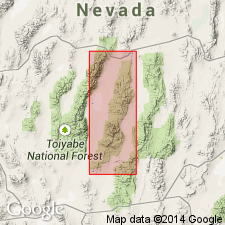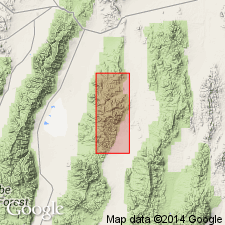
- Usage in publication:
-
- Clipper Canyon Group
- Modifications:
-
- First used
- Biostratigraphic dating
- AAPG geologic province:
-
- Great Basin province
Summary:
Clipper Canyon Group in Toquima Range, NV (also referred to as Clipper Canyon sequence) consists of (ascending): Charcoal Canyon, Petes Summit, Sams Spring, and Joes Canyon Formations. Graptolites and associated fauna are listed for Petes Summit and Sams Spring Formations. Age of group is Ordovician (Arenigian through Caradocian). [Name "Clipper Canyon Sequence" used by Kay (1960)].
Source: GNU records (USGS DDS-6; Menlo GNULEX).

- Usage in publication:
-
- Clipper Canyon Group
- Modifications:
-
- Named
- Dominant lithology:
-
- Siltstone
- Argillite
- Chert
- AAPG geologic province:
-
- Great Basin province
Summary:
Clipper Canyon Group occurs in area of about 25 sq mi in drainage of Clipper (or Clipper Gap) Canyon and adjoining Petes Canyon, Toquima Range, Nye and Lander Cos, NV. Has been called Clipper Canyon sequence (Kay, 1960, 1962). Consists of (ascending): Charcoal Canyon, Petes Summit, Sams Spring, and Joes Canyon Formations. These are shown on geologic map of Petes Summit Sheet. Age of group is given as Ordovician based on graptolites in Petes Summit and Sams Spring Formations and stratigraphic relations.
Source: GNU records (USGS DDS-6; Menlo GNULEX).
For more information, please contact Nancy Stamm, Geologic Names Committee Secretary.
Asterisk (*) indicates published by U.S. Geological Survey authors.
"No current usage" (†) implies that a name has been abandoned or has fallen into disuse. Former usage and, if known, replacement name given in parentheses ( ).
Slash (/) indicates name conflicts with nomenclatural guidelines (CSN, 1933; ACSN, 1961, 1970; NACSN, 1983, 2005, 2021). May be explained within brackets ([ ]).

